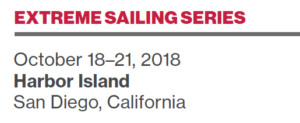
For years, the inherent challenge for spectators at a sailing event was the field of play itself. Boats would go out to sea and hours later they would return, with few ways for fans to see any of the action.
That has been changing in recent years, as the sport’s pinnacle event, the America’s Cup, has moved its competition close to shore in San Francisco (2013) and Bermuda (2017). But another event series has been taking that approach for the past 11 years—the Extreme Sailing Series.

After a six-year stretch without a U.S. stop, the series came to San Diego last year for its distinctive style of racing, featuring hydro-foiling GC32 catamarans on short courses. After the success of that event, the tour will return to the Southern California sailing hub again this fall for the sixth leg of a seven-stop global series. (Previous tour stops this year have been in Oman, Italy, Spain, Portugal and the U.K.)
“Extreme Sailing Series pioneered what the sport of sailing considers to be stadium racing,” said Matt Reynolds, CEO of Extreme San Diego, which serves as the local organizing committee with support from the San Diego Tourism Authority and the Port of San Diego. “What they do is book iconic venues around the world where you can sail really close to shore.”
In San Diego, the event will be staged near Harbor Island, a man-made peninsula that poses its own challenges because of its proximity to the city’s airport and Navy facilities. “It’s more difficult to shut down the water because you’ve got huge aircraft carriers going through there and it needs to be patrolled, and you’ve got pleasure boats, so we need support from the city,” said Scott Over, the race series’ commercial director.
In addition to being close to shore, the races will be relatively short, with most taking just 10 to 15 minutes. Fans can watch all the racing in the harbor, but there will also be plenty for them to do on land, with a village concept that will cater to all ages with kids’ races, beer gardens and other food and entertainment options. “We work really hard to drive people down to the venue so they can enjoy the day,” Reynolds said.
Extreme Sailing also offers an option that may be unique in all of sports. With a VIP package, fans can buy their way onto the boat itself, strapped in to see the action firsthand. “For the sailor, they’re looking around seeing the world’s best sailors doing what they do on the weekend, just a lot faster and a lot more efficient on a boat going eight times as fast,” Over said. “If you’re a layman, it’s just the most unbelievable roller coaster ride of your life. It’s a pretty fantastic experience.”
The San Diego stop will precede the next event in Cabo San Lucas, Mexico, and race organizers say there’s a natural link between the stops. In addition, the Mexican Tourism Board will use the sport to promote tourism in the country. “They’ve never used sailing as a tool to promote their country, but Mexico has one of the biggest coastlines in the world on either side, and it’s one of their biggest selling points,” Over said.
Local organizers in San Diego are hoping to build on the momentum from last year’s event, where an estimated 20,000 watched the racing action. In the end, Reynolds said promoting the sport is the ultimate goal.
“A lot of people ask us what the most important thing is, and that’s to raise awareness and build a fan base that can get excited and come down every year and see something that’s quite unique,” Reynolds said. “You can be a non-sailor and go see this and actually enjoy it, and that’s something sailing has not done a very good job with in the past. We’re breaking new ground.”










 Copyright © 2024 by Northstar Travel Media LLC. All Rights Reserved. 301 Route 17 N, Suite 1150, Rutherford, NJ 07070 USA | Telephone: (201) 902-2000
Copyright © 2024 by Northstar Travel Media LLC. All Rights Reserved. 301 Route 17 N, Suite 1150, Rutherford, NJ 07070 USA | Telephone: (201) 902-2000